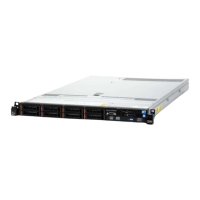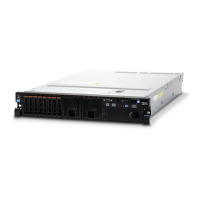L = 1.35 V specified, 1.5 V operable
Note: Values for these voltages are ‘specified’ which means the device
characteristics such as timing are supported at this voltage.
Values are ‘operable’ which means that the devices can be
operated safely at this voltage. However, device characteristics
such as timing may not be guaranteed. All devices must be
‘tolerant’ of the highest DDR3 nominal voltage of 1.5 V, meaning
that they may not operate at 1.5 V but may be powered at that
voltage without damage to the devices.
wwwww is the DIMM bandwidth, in MBps
6400 = 6.40 GBps (DDR3-800 SDRAMs, 8-byte primary data bus)
8500 = 8.53 GBps (DDR3-1066 SDRAMs, 8-byte primary data bus)
10600 = 10.66 GBps (DDR3-1333 SDRAMs, 8-byte primary data bus)
12800 = 12.80 GBps (DDR3-1600 SDRAMs, 8-byte primary data bus)
m is the DIMM type
E = Unbuffered DIMM (UDIMM) with ECC (x72-bit module data bus)
L = Load Reduction DIMM (LRDIMM)
R = Registered DIMM (RDIMM)
U = Unbuffered DIMM with no ECC (x64-bit primary data bus)
aa is the CAS latency, in clocks at maximum operating frequency
bb is the JEDEC SPD Revision Encoding and Additions level
cc is the reference design file for the design of the DIMM
d is the revision number of the reference design of the DIMM
Note: To determine the type of a DIMM, see the label on the DIMM. The
information on the label is in the format xxxxx nRxxx PC3v-xxxxxx-xx-xx-
xxx. The numeral in the sixth numerical position indicates whether the
DIMM is single-rank (n=1), dual-rank (n=2), or quad-rank (n=4).
v The following rules apply to DDR3 RDIMM speed as it relates to the number of
RDIMMs in a channel:
– When you install 1 RDIMM per channel, the memory runs at 1600 MHz
– When you install 2 RDIMMs per channel, the memory runs at 1600 MHz
– When you install 3 RDIMMs per channel, the memory runs at 1066 MHz
– All channels in a server run at the fastest common frequency
– Do not install registered, unbuffered, and load reduction DIMMs in the same
server
v The maximum memory speed is determined by the combination of the
microprocessor, DIMM speed, DIMM type, Operating Modes in UEFI settings,
and the number of DIMMs installed in each channel.
v In two-DIMM-per-channel configuration, a server with an Intel Xeon
™
E5-2600
series microprocessor automatically operates with a maximum memory speed of
up to 1600 MHz when the following condition is met:
– Two 1.35 V single-rank, dual-ranl, or quad-rank UDIMMs, RDIMMs or
LRDIMMs are installed in the same channel. In the Setup utility, Memory
speed is set to Max performance and LV-DIMM power is set to Enhance
performance mode. The 1.35 V UDIMMs, RDIMMs or LRDIMMs will function
at 1.5 V.
v The server supports a maximum of 16 dual-rank UDIMMs. The server supports
up to two UDIMMs per channel.
78 IBM System x3500 M4 Type 7383: Installation and User’s Guide

